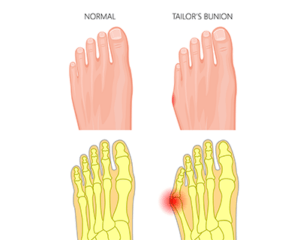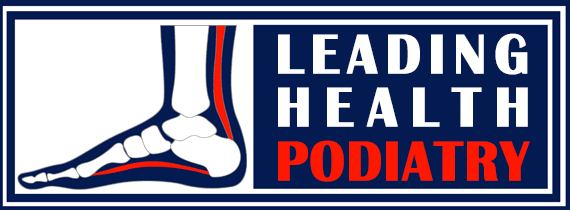Tailor’s Bunions
What is a Tailor’s Bunion?
A Tailor’s bunion, also known as a bunionette, is a bony lump that develops on the outside of the foot at the base of the little (fifth) toe. Similar to a standard bunion, it occurs when the fifth toe joint becomes misaligned, often due to pressure, friction, or structural foot imbalances.
The name “Tailor’s bunion” comes from the historical practice of tailors sitting cross-legged while working, which placed pressure on the outer edge of their feet, making them more prone to developing this condition.

Tailor’s Bunion Symptoms
The most common symptoms of a Tailor’s bunion include:
- Bony lump on the outer side of the foot, near the fifth toe joint.
- Pain and tenderness, especially when wearing tight-fitting shoes.
- Redness and swelling around the affected joint due to irritation of soft tissues.
- Calluses or corns forming over the bunion from repeated friction against footwear.
Symptoms tend to worsen with narrow shoes, prolonged walking, or high-impact activities, as these can increase pressure on the bunion.
What Causes a Tailor’s Bunion?
A Tailor’s bunion develops due to a combination of foot biomechanics, footwear choices, and genetic factors. Common causes include:
1. Foot Structure & Biomechanics
- Excessive weight on the outer foot (supinated foot type).
- Forefoot widening or splaying, which increases pressure on the fifth toe joint.
- Tight calf muscles, leading to increased stress on the ball of the foot.
2. Footwear Choices
- Narrow or tight-fitting shoes that push the little toe inward, altering joint alignment.
- High heels, which force the foot forward, increasing pressure on the bunion.
3. Genetic Factors
- Inherited foot structure abnormalities can make some individuals more prone to developing bunionettes.
Tailor’s Bunion Treatment
The goal of treatment is to reduce pain, inflammation, and pressure on the affected joint while preventing further progression.
Non-Surgical Treatment Options:
✔ Wearing wide-fitting, supportive shoes – Avoiding narrow or high-heeled footwear helps relieve pressure.
✔ Orthotics or custom insoles – Redistribute weight and reduce joint stress.
✔ Padding and shoe modifications – Protect the bunion from rubbing against footwear.
✔ Stretching and strengthening exercises – Improve foot flexibility and stability.
✔ Anti-inflammatory medication – Reduce pain and swelling.
When is Surgery Needed?
If conservative treatments do not relieve symptoms, and the bunion continues to interfere with daily activities, surgical correction may be an option. This typically involves realigning the joint to reduce pain and restore function.
Expert Podiatry Care for Tailor’s Bunions
If you’re experiencing foot pain or discomfort from a Tailor’s bunion, our podiatrists at Leading Health Podiatry can help. We offer expert diagnosis and customised treatment plans to get you back on your feet comfortably.
📅 Book an appointment today!
